Unveiling Yamdrok Lake: An Insider’s Guide to Tibet’s Sacred Waters
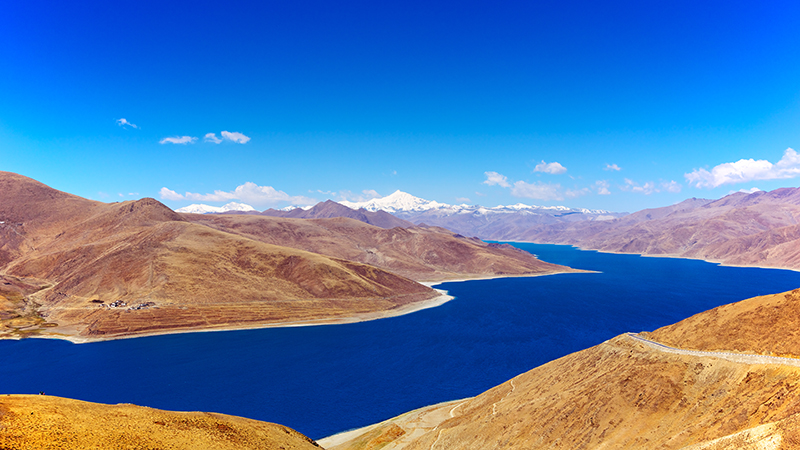
An Essential Guide to Visiting Yamdrok Lake
Nestled in the heart of Tibet, Yamdrok Lake is often described as a shimmering jewel set against the backdrop of the majestic Himalayas. Revered as one of the three holiest lakes in Tibetan Buddhism, its striking turquoise waters stretch across an area of 678 square kilometers, captivating the hearts of travelers and photographers alike. Just a short two-hour drive from Lhasa, this pristine lake is not only an oasis of serenity but also a vibrant hub of cultural experiences, making it an essential stop on your Tibetan journey.
As you approach Yamdrok Lake, prepare to be awed by the breathtaking vistas that unfold along the winding roads. The journey itself is an adventure, taking you over high mountain passes, including the famed Gampala Pass, where you can witness the spectacular panoramic views. Once you arrive, the lake’s ever-changing colors, influenced by the seasons and the sky, create a mesmerizing dance of hues that beckons you to linger.
But Yamdrok Lake is more than just a pretty picture. It’s a place to immerse yourself in authentic Tibetan culture. Meet local herding families, savor traditional butter tea, and learn about their way of life against the stunning backdrop of the lake. Whether you’re seeking adventure through birdwatching, photography, or simply unwinding along the tranquil shores, Yamdrok Lake offers an unforgettable experience that captures the essence of Tibet.
So pack your camera and prepare your spirit for adventure, as Yamdrok Lake awaits to enchant you with its beauty and serenity.
In This Guide
- An Essential Guide to Visiting Yamdrok Lake
- The Rich History and Legends of Yamdrok Lake
- Main Highlights: What You Absolutely Can’t Miss
- Planning Your Visit: A Practical Guide
- Tickets: Prices, Booking, and Tips
- How to Get There: A Complete Transportation Guide
- Local Cuisine and Accommodation Nearby
- Frequently Asked Questions
- Final Thoughts on Your Trip
The Rich History and Legends of Yamdrok Lake
Yamdrok Lake, a shimmering jewel nestled in the heart of Tibet, is not just a feast for the eyes but a canvas painted with rich history and legends that echo through the ages. Revered as one of Tibet’s three sacred lakes, alongside Namtso and Manasarovar, Yamdrok Lake holds a significant place in both the spiritual and cultural tapestry of the region.
A Sacred Site
According to Tibetan Buddhism, Yamdrok Lake is considered the embodiment of the goddess Tara, a deity associated with compassion and protection. The lake’s tranquil waters are believed to possess healing properties, attracting pilgrims who journey from afar to seek blessings and solace in its divine presence. This spiritual connection is amplified by the stunning backdrop of snow-capped mountains that cradle the lake, creating an ethereal landscape that inspires reverence and introspection.
Historical Significance
The history of Yamdrok Lake dates back centuries, intertwined with the ancient narratives of Tibetan nomads and their harmonious relationship with nature. Historically, the lake has served as a vital resource for local herders, providing water for livestock and an abundant source of fish. The surrounding areas are dotted with traditional Tibetan villages, where the customs and lifestyles have remained largely unchanged over time. These communities have thrived on the lake’s bounty, weaving their livelihoods into the fabric of the landscape.
Legends and Myths
Yamdrok Lake is steeped in legends that add to its mystique. One such legend speaks of a young girl who transformed into a spirit to protect the lake from pollution and desecration. It is said that her spirit continues to watch over Yamdrok, ensuring that its waters remain pure and its beauty unspoiled. Travelers often recount tales of encountering her presence in the whispers of the wind and the gentle ripples of the water.
Another popular legend involves the lake’s rich turquoise color, which is said to symbolize the blessings of the sky and the earth. It is believed that the vibrant hues are a reflection of the lake’s spiritual essence, representing the harmony between the physical and the metaphysical. As the seasons change, so too does the lake’s palette, captivating visitors and locals alike with its ever-shifting beauty.
Cultural Heritage
The cultural significance of Yamdrok Lake is also evident in the numerous monasteries and spiritual sites that dot its shores. Local herders often embark on pilgrimages to these sacred spots, where they engage in religious rituals and offer prayers to the deities believed to inhabit the lake. The harmony between the natural environment and spiritual practice is a cornerstone of Tibetan culture, and Yamdrok Lake stands as a testament to this deep-rooted tradition.
Contemporary Reflections
In modern times, Yamdrok Lake has emerged as an alluring destination for travelers seeking not only breathtaking views but also an authentic encounter with Tibetan culture and spirituality. Visitors often take the time to engage with local herders, sharing stories and traditions that have been passed down through generations. This exchange fosters a deeper understanding of the lake’s significance, transforming a mere visit into a profound journey of discovery.
In conclusion, Yamdrok Lake is more than just a picturesque landscape; it is a living testament to the intertwining of history, spirituality, and culture in Tibet. As you stand at the lakeshore, gazing into its depths, you are not just witnessing a natural wonder; you are stepping into a realm where legends come alive, and the spirit of the land continues to thrive. The rich history and legends of Yamdrok Lake invite you to explore its depths, offering a unique glimpse into the soul of Tibetan heritage.
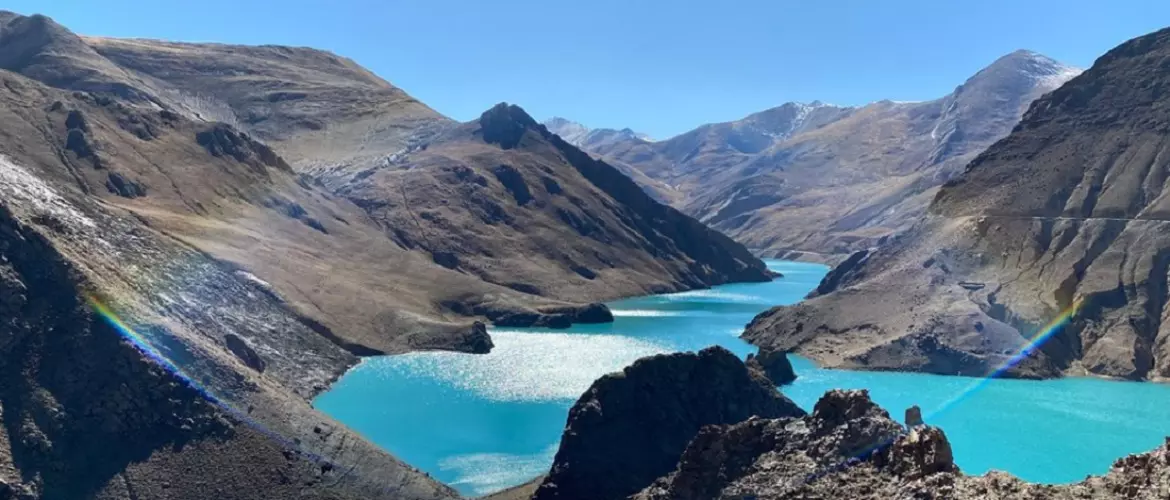
Yamdrok Lake.
Main Highlights: What You Absolutely Can’t Miss
Yamdrok Lake, one of Tibet’s most revered natural wonders, is a dazzling sight that captivates travelers with its stunning turquoise waters and surrounding snow-capped peaks. Here are the key highlights that you absolutely cannot miss during your visit to this breathtaking lake.
Gampala Pass Viewing Platform
At an elevation of 4,998 meters, the Gampala Pass offers the most iconic panoramic views of Yamdrok Lake. This is a must-stop location for photographers and nature lovers alike. As you stand at this vantage point, the lake stretches out in vibrant hues of blue and green, framed by rugged mountains. Be prepared to wait in line during peak season, as this spot is extremely popular among tourists.
Lurila Viewing Platform
For those seeking a slightly quieter experience, the Lurila Viewing Platform provides a unique perspective of the lake. Here, you can capture stunning images of the small islands dotting the surface and the remote Rutog Monastery in the distance. This lesser-known spot is favored by photographers looking for a tranquil setting to admire the lake’s beauty.
Local Herder Family Visit
Immerse yourself in the local culture by visiting a nomadic herder family. This experience allows you to sip authentic Tibetan butter tea, savor homemade dishes, and learn about the daily lives of these resilient communities. Interacting with the locals provides a deep appreciation of their traditions and way of life, making your journey to Yamdrok Lake even more meaningful.
Birdwatching Opportunities
The shores of Yamdrok Lake are a paradise for birdwatchers, particularly in the spring and summer months. The hovering brown-headed gulls and other migratory birds provide excellent opportunities for wildlife photography. Bring your binoculars and enjoy the sights and sounds of nature as you explore the serene lakeside.
Seasonal Splendor
Yamdrok Lake transforms with the seasons, providing diverse experiences throughout the year. Spring brings blooming wildflowers and thawing ice, while summer showcases lush green grasslands and vibrant blue waters. Autumn offers crisp air and breathtaking views as snow begins to blanket the higher peaks. Even winter, with fewer crowds, reveals the lake’s deep blue hues against a backdrop of snow-covered mountains.
Tibetan Mastiffs and Yaks
Don’t miss the chance to interact with local Tibetan mastiffs and ride decorated yaks offered by herders around the lake. For a small fee, you can cuddle these friendly animals and capture memorable photos, enhancing your adventure with a touch of local flavor.
Photography Hotspots
Be sure to visit the Langbuqi Viewing Platform, another excellent location for capturing the lake’s beauty. Whether you’re an amateur photographer or a seasoned pro, the vibrant colors and unique landscapes will provide plenty of stunning subject matter. Remember to bring your camera and a sturdy tripod to make the most of the picturesque surroundings.
Prepare for the Elements
Yamdrok Lake lies at a high altitude, and the weather can change unexpectedly. Be ready for wind and intense UV exposure, especially at the viewing platforms. Dress in layers, bring sunblock, and stay hydrated to ensure a comfortable visit.
Yamdrok Lake is more than just a destination; it’s an experience that combines natural beauty, cultural immersion, and unforgettable moments. Make sure to include these highlights in your itinerary for a truly enriching visit to one of Tibet’s most sacred lakes.

Yamdrok Lake.
Planning Your Visit: A Practical Guide
When planning your visit to the breathtaking Yamdrok Lake, there are several practical considerations to ensure a smooth and enjoyable experience. This guide outlines essential tips and information for international travelers eager to explore one of Tibet’s most stunning natural wonders.
Acclimatization is Key
Yamdrok Lake sits at an altitude of 4,441 meters (14,570 feet), making proper acclimatization crucial. Although it’s only a two-hour drive from Lhasa, arriving directly after flying in can lead to altitude sickness. It is recommended to spend at least 3-4 days in Lhasa (which is at a lower elevation of 3,656 meters) to acclimatize. During this time, explore iconic sites like the Potala Palace and Jokhang Temple.
Duration of Visit
To fully appreciate Yamdrok Lake, plan for at least a full day. Many tours include a quick stop at the lake, but to experience its beauty and tranquility, consider spending the day hiking along its shores, birdwatching, and visiting local herder families. If you wish to delve deeper into the area, consider a dedicated multi-day tour that incorporates various local experiences.
Accommodation Considerations
There are no accommodations directly at Yamdrok Lake due to its high altitude and the potential risk of altitude sickness. Most travelers return to Lhasa or head to Shigatse for the night, where you can find a range of hotels from budget to luxury options.
Best Time to Visit
Yamdrok Lake is stunning year-round, with each season offering unique scenery:
– Spring (March to May): Witness the thawing of the icy lake and blooming wildflowers.
– Summer (June to August): Enjoy warm temperatures and vibrant turquoise waters; this is the peak season for outdoor activities.
– Autumn (September to November): Experience crisp air and clear skies, perfect for capturing panoramic views.
– Winter (December to February): Fewer tourists and a mesmerizing deep blue lake against snow-covered mountains, but be prepared for cold temperatures.
Check the weather forecast before your visit, as conditions can change rapidly.
Weather Preparedness
Given the high elevation, expect windy conditions and intense UV exposure year-round. Bring windproof clothing and ensure you have sunscreen (SPF 50+) and sunglasses to protect against strong sunlight. Staying hydrated is also crucial, so carry plenty of water during your excursions.
Local Experiences
Engaging with the local culture is a highlight of visiting Yamdrok Lake. You can visit nomadic herder families, learn about their way of life, and sample traditional Tibetan butter tea and local dishes. This immersive experience offers a glimpse into the daily lives of the Tibetan people, which is unlike anything you might encounter in urban environments.
Capture the View
For photography enthusiasts, the best spots to capture the beauty of Yamdrok Lake are the Gampala Pass (4,998 m), Langbuqi Viewing Platform (4,677 m), and the quieter Lurila Viewing Platform (4,960 m). Be prepared for queues during the peak season, as these locations are popular among tourists.
Additional Tips
- Early Departures: To avoid crowds and maximize your time at the lake, consider leaving early in the morning.
- Local Fees: There may be small fees to interact with Tibetan mastiffs or ride decorated yaks, typically ranging from $2 to $5 USD.
- Respect the Environment: As with any natural wonder, be mindful of the environment. Avoid littering and be respectful of local customs and wildlife.
By following these practical tips, your visit to Yamdrok Lake can be an unforgettable adventure filled with stunning vistas and rich cultural experiences. Enjoy the journey to one of Tibet’s most cherished treasures!
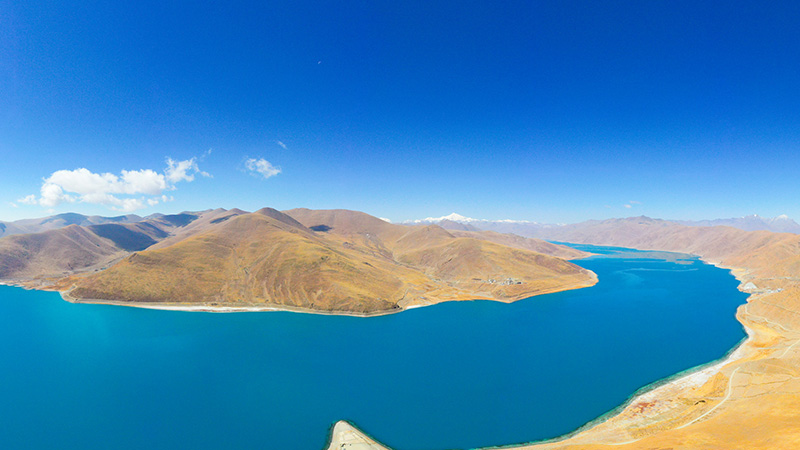
Yamdrok Lake.
Tickets: Prices, Booking, and Tips
When planning your visit to the breathtaking Yamdrok Lake, it’s essential to understand your options for tickets, pricing, and the best ways to book your experience.
Admission & Fees
Unlike many popular tourist sites, there is no dedicated entrance fee for Yamdrok Lake itself. However, if you wish to engage with local Tibetan herders, such as cuddling with their well-adorned lambs or riding decorated Tibetan yaks, expect to pay a small fee of approximately $2 to $5. This is a fantastic opportunity to capture memorable photos and interact with the local culture.
Booking Your Tour
To truly immerse yourself in the beauty of Yamdrok Lake, consider booking a guided tour. While you can visit the lake independently, a local tour will enhance your experience with knowledgeable guides and insights into Tibetan culture. Many tours include transportation from Lhasa, and some even offer additional activities like visiting local herder families, which can enrich your visit significantly.
-
Group Tours: Small group tours often provide a more personal experience. Options range from one-day excursions that cover the highlights of the lake to more in-depth multi-day tours that include local interactions and visits to nearby attractions like Gyantse and Shigatse.
-
Private Tours: For those seeking a tailored experience, private tours can be arranged, allowing you to set your own schedule and explore at your own pace.
-
Accommodations: Since there are no hotels directly at Yamdrok Lake, most tours will return you to Lhasa or take you onward to Shigatse for overnight stays. Make sure to book your accommodations in advance, especially during peak tourist seasons.
Tips for Booking
- Book Early for Discounts: Many tour operators offer early bird discounts, so it’s wise to secure your spot as soon as your travel plans are confirmed.
- Check the Weather: Given the unpredictable weather conditions, check forecasts before your visit. This ensures you’re prepared for any changes that could affect your trip.
- Plan for Altitude: Remember to acclimatize in Lhasa before heading to Yamdrok Lake. Spending a few days exploring the capital will help your body adjust to the high altitude.
Popular Tour Options
- 8-Day Lhasa to Everest Base Camp Tour: This iconic tour includes a visit to Yamdrok Lake on the way to Everest Base Camp, providing a comprehensive Tibetan experience. Prices start at around $949 per person.
- 5-Day Lhasa to Yamdrok Lake Tour: For those focused solely on the lake, this tour allows for an immersive experience with local herders and stunning views. Prices begin at $689 per person.
By understanding the ticketing process and planning your visit with these tips, you’ll be well on your way to experiencing the stunning tranquility and spiritual significance of Yamdrok Lake. Enjoy your journey!
How to Get There: A Complete Transportation Guide
Reaching the breathtaking Yamdrok Lake is an adventure in itself, combining stunning landscapes with the thrill of high-altitude travel. Here’s your comprehensive guide on how to get there, ensuring a seamless journey to one of Tibet’s most revered and photogenic lakes.
Getting to Yamdrok Lake from Lhasa
Start in Lhasa
Yamdrok Lake is approximately 108 kilometers (67 miles) southeast of Lhasa, the capital of Tibet. The drive takes about 2 hours via the G4218 Expressway and the winding G349 National Highway. However, it’s important to note that due to the high altitude of both Lhasa (3,656 meters or 12,000 feet) and Yamdrok Lake (4,441 meters or 14,570 feet), acclimatization is crucial. It is highly recommended to spend at least 3-4 days exploring Lhasa to adjust to the altitude before embarking on your journey to the lake.
Transportation Options:
-
Private Car Hire
The most comfortable and flexible option is to hire a private vehicle with a driver. This allows you to travel at your own pace, stop for photographs along the way, and enjoy the stunning scenery without the rush. -
Group Tours
Many local tour operators offer organized group tours that include transportation to Yamdrok Lake as part of a larger itinerary. This is a great way to meet fellow travelers and benefit from the expertise of local guides who can provide insights about the area. -
Public Transport
While public buses are available, they are less frequent and may not offer the same level of comfort as private transport. If you’re an experienced traveler looking for an adventure, you can take a bus from Lhasa to Gyantse, and then transfer to another bus heading towards Yamdrok Lake. Be prepared for a longer travel time and limited schedules.
What to Expect on the Road
The journey from Lhasa to Yamdrok Lake is filled with breathtaking views, especially as you ascend to the Gampala Pass, which sits at an altitude of 4,998 meters (16,432 feet). This pass offers stunning panoramic views of the lake and the surrounding mountains, making it a perfect spot for photographs. However, due to the elevation, be cautious of altitude sickness and take necessary precautions, such as staying hydrated and taking it slow.
Accommodations Nearby
While there are no accommodations directly at Yamdrok Lake, travelers typically head to either Shigatse (about 2 hours away) or back to Lhasa for the night. Both cities offer a range of accommodation options, from luxury hotels to budget-friendly hostels. Shigatse is a great choice if you’re continuing your journey to Everest Base Camp, while Lhasa offers a vibrant atmosphere with plenty of dining and cultural experiences.
Seasonal Considerations
Yamdrok Lake can be visited year-round, but weather conditions can vary greatly. Spring and autumn are particularly beautiful, with mild temperatures and stunning scenery. Summer is warm and vibrant, while winter offers a serene, less crowded experience. Regardless of when you visit, always check the weather forecast and be prepared for sudden changes.
Important Tips
- Early Departures: For the best experience, plan for an early departure to avoid crowds and enjoy the tranquility of the lake.
- Wind and UV Protection: Given the high altitude, be prepared for wind and strong UV rays. Wear a windproof jacket, apply sunscreen, and bring sunglasses.
- Cultural Engagement: If time allows, consider visiting a local herder family near the lake for a unique cultural experience.
With this guide in hand, you’re well-equipped to embark on a memorable journey to Yamdrok Lake, where natural beauty and Tibetan culture await. Enjoy your adventure!
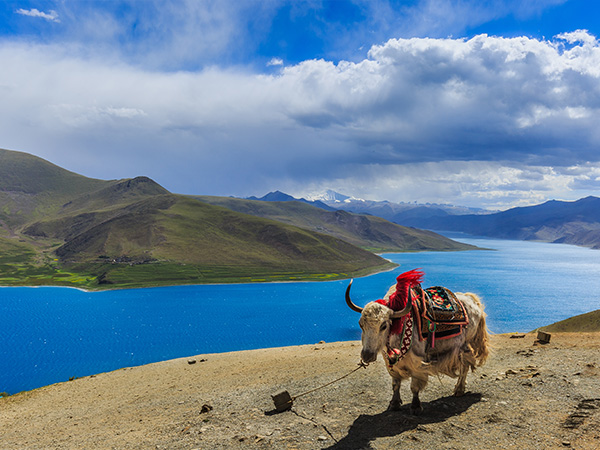
Yamdrok Lake.
Local Cuisine and Accommodation Nearby
When planning a visit to the breathtaking Yamdrok Lake, it’s essential to consider both your culinary experiences and accommodation options nearby. While there are no hotels directly at the lake due to its high altitude and the risk of altitude sickness, you’ll find delightful options in the nearby towns of Shigatse and Gyantse, both of which serve as excellent bases for exploring this stunning location.
Local Cuisine
Tibetan cuisine is a unique blend of flavors and traditions that will enrich your travel experience. While in Shigatse or Gyantse, make sure to try these local delicacies:
-
Momos: These delicious Tibetan dumplings, filled with meat or vegetables, are a must-try. Look for them in local eateries, where they are often served with a spicy dipping sauce.
-
Tsampa: A staple food made from roasted barley flour, it’s typically mixed with butter tea or water to form a dough-like consistency. It’s hearty and provides the energy needed for your high-altitude adventures.
-
Tibetan Butter Tea: Known as po cha, this traditional drink is made from tea, yak butter, and salt. It’s a warming beverage perfect for the cold climate and will give you a taste of Tibetan hospitality.
-
Yak Meat: Often found in stews or grilled, yak meat is a flavorful option that is both nutritious and filling. Seek out local restaurants that specialize in this traditional meat.
-
Local Dairy Products: Don’t miss the chance to sample fresh yak cheese and yogurt, which are commonly available in the region and offer a unique taste of Tibetan dairy farming.
Accommodation Options
Since there are no accommodations directly at Yamdrok Lake, you’ll want to return to Shigatse or Gyantse after your day of exploration. Here are some recommended places to stay:
In Shigatse:
-
Hilton Shigatse: Offering modern amenities and spacious rooms, this hotel provides breathtaking views of the surrounding mountains. It’s a great choice for those looking for comfort after a long day of sightseeing.
-
Tashi Choten Hotel: A more budget-friendly option that still offers comfortable accommodations. The hotel is known for its friendly staff and is conveniently located near Shigatse’s attractions.
In Gyantse:
-
Gyantse Hotel: This hotel balances affordability with comfort. It features clean rooms and a restaurant that serves both Tibetan and Chinese dishes.
-
Zhaolong Hotel: Known for its hospitable service and cozy atmosphere, this hotel is perfect for travelers seeking a more intimate experience. It’s also a great base to explore the ancient Gyantse Dzong fortress and the Kumbum Stupa.
With your appetite sated by local delicacies and a cozy place to rest, you’ll be well-prepared to explore the mesmerizing beauty of Yamdrok Lake and the surrounding Tibetan landscape. Whether you’re photographing the turquoise waters or enjoying the serene atmosphere, your culinary and accommodation choices will enhance your unforgettable journey.
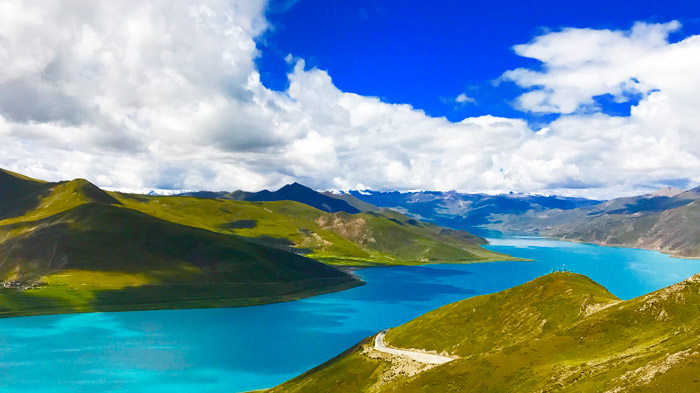
Yamdrok Lake.
Frequently Asked Questions
Frequently Asked Questions about Visiting Yamdrok Lake
1. How far is Yamdrok Lake from Lhasa, and how should I prepare for the altitude?
Yamdrok Lake is approximately 108 kilometers (about 67 miles) southeast of Lhasa, which translates to around a 2-hour drive. However, it’s crucial to spend 3-4 days in Lhasa first to acclimatize to the altitude (3,656 meters or 12,000 feet) before making the trip to the lake, as the elevation at Yamdrok Lake is 4,441 meters (14,570 feet). This helps reduce the risk of altitude sickness.
2. Can I stay overnight near Yamdrok Lake?
There are no accommodations directly at Yamdrok Lake due to its high altitude and lack of infrastructure. Most travelers return to Lhasa or head to Shigatse for a night’s rest, where there are plenty of hotel options ranging from budget to luxury.
3. What is the best time of year to visit Yamdrok Lake?
Yamdrok Lake is stunning year-round, but the best times to visit are during spring (March to May) when wildflowers bloom, and autumn (September to November) for clear skies and beautiful views. Summer (June to August) offers pleasant weather for outdoor activities, while winter (December to February) provides a serene atmosphere with fewer tourists but cold temperatures.
4. What should I wear when visiting Yamdrok Lake?
Given the high elevation, you should dress in layers and include a windproof jacket to protect against sudden gusts of wind. A wide-brimmed hat, sunglasses, and sunscreen (50+ SPF) are also essential for protection against high UV exposure. Don’t forget to stay hydrated!
5. Are there any fees to interact with local animals around the lake?
Yes, local herders often allow visitors to interact with their animals, such as Tibetan mastiffs and yaks, for a small fee ranging from 2 to 5 USD. This can be a memorable experience, especially for animal lovers!
6. What are the best spots for photography at Yamdrok Lake?
The top three viewing platforms for capturing breathtaking photos of Yamdrok Lake include the Gampala Pass (4,998 meters), Langbuqi Viewing Platform (4,677 meters), and the more secluded Lurila Viewing Platform (4,960 meters). Be prepared to wait in line during peak tourist seasons for the best shots.
7. Is it safe to visit local herder families during the tour?
Absolutely! Visiting a local herder family provides an authentic cultural experience. These families are generally welcoming and eager to share their traditions. You can enjoy homemade Tibetan butter tea and traditional dishes while learning about their lifestyle.
8. How can I ensure a more in-depth experience at Yamdrok Lake?
To fully explore the beauty and culture around Yamdrok Lake, consider booking an in-depth tour that spans at least a full day. This allows you to appreciate the lake’s stunning vistas, engage with local communities, and discover hidden Buddhist monasteries without feeling rushed.
Final Thoughts on Your Trip
As your journey to Yamdrok Lake draws to a close, take a moment to reflect on the breathtaking beauty and rich culture you’ve encountered. This stunning turquoise oasis, nestled amidst the towering Himalayan peaks, offers not just a visual feast but also a profound connection to the serene Tibetan landscape and its resilient people.
Whether you marveled at the shimmering waters, embraced the invigorating mountain air, or shared warm moments with local herders, every experience at Yamdrok Lake is a cherished memory waiting to be savored. The tranquil shores beckon for quiet contemplation, while the vibrant colors shift with the seasons, reminding us of nature’s ever-changing artistry.
As you return to the bustling pace of life, carry with you the tranquility of Yamdrok Lake and the stories of the land and its people. Let this journey inspire future explorations and a deeper appreciation for the world’s hidden gems. Until you return to the enchanting heights of Tibet, may your travels continue to be filled with discovery and wonder. Safe travels!